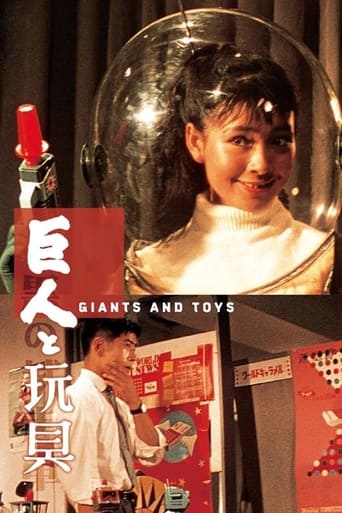Vibhor Goyal
The movie is a true masterpiece by Yasuzo Masumura in which the cut throat rivalry for money between various companies at that time(Post World war) is beautifully portrayed .The movie is successful in giving us the picture of japan at that time and how the people of japan consider Americans superior and try to copy the m.It also shows how Corporatization and commercialization of Japan have dehumanized everything The director Masumura Yasuzo was successful in giving the complete picture of the japan after world war ll .The film beautifully satirizes the instant manufacture of media stars, the decline of gentlemanly business ethos and rise of culture of ruthless corporate skulduggery, and the emphasis on work at the expense of personal life and health as shown Mr.Goda was coughing blood in the end.The movie clearly showed how Corporatization and commercialization of japan had dehumanized every thing it had touched.
MartinHafer
"Kyojin To Gangu" ("Giants & Toys") is a very insightful film that manages to tackle two serious social problems at the same time--and does it with comedy. The first problem is more a Japanese problem--the way that corporations in Japan have become cut-throat and all-consuming. It appears that following the death of the militarists at the end of WWII, this spirit of competition has back taken up by large companies--who see business like Napoleon saw the rest of Europe! The second problem is the vacuousness and fleeting nature of fame. This is timely not just in 1958 but even more so today, as we have achieved depths of shallowness that would put the 1950s to shame! The film begins with World Candy Company. While they are one of the leaders in the industry and have brisk sales, in this world of corporate warfare, this isn't good enough--their two nearest competitors must be obliterated! And one rising star in the company has a marketing idea when he sees a very peppy yet ugly-toothed young girl--he'll make her a star and then sign her to represent World. Now I was confused by this cute lady. You'd THINK someone with terrible teeth would not only NOT be adored by the public but would make a terrible spokesperson for a candy company. But, the man turns out to be correct--if you market the heck out of someone, no matter how pointless they might be, the public are like sheep and will adore her. This is every bit as true today as it was in the 50s--perhaps even more so. As the lady becomes more and more and more famous for NOTHING, it's interesting to see how this impacts the executives at World--who, in a couple cases, start coughing up blood due to the pressure to win.Interestingly, while Kyoko was 100% fake and created by marketers, after a while, the sweetness and peppiness that made her endearing began to wear off. And, in its place, was a certain crassness and vacuousness. In the process, this malleable lady suddenly wasn't so cooperative and malleable any more. It seems like the plan might be backfiring. What's to become of World's desire to rule the candy world? This movie was interesting because although it was very, very cynical, it managed to also be humorous and light at the same time. This helped the film quite a bit--as did the look of the movie and advertising campaign. While you would never think of the films together because they are so different in many ways, the 2011 American film "The Greatest Movie Ever Sold" would be a great film to see along with "Giants & Toys". It just happened by chance that this was exactly what I did--and each enhanced the other as they both have a lot say about advertising and the public.
Comics230
Giants & Toys - One the main reasons I watched Giants & Toys was for the simple theme of the 1950's space craze. I love that era and 1950's Science Fiction. And I wasn't disappointed, I loved to see all the toys used as props in the movie, more than once stopping to get better look at them. What that stuff would be worth on eBay! It seems frivolous, but it did get me to watch the movie.Giants & Toys is biting commentary on then contemporary 1950's Japanese life. It shows a society where corporations have taken over the Samuri Class role. Life belongs to your company. In the end, even beating down the most idealistic employee. From all I've read about Japanese corporate culture, this is what it is like.More than just commentary on Japanese life, Yasuzo Masumura (director), Takeshi Kaikô (novel) and Yoshio Shirasaka (writer) are prophetic in the assessment of pop culture and media even in today's society. About thirty minutes into the movie there a line about "stars getting their 15 minutes of fame." Now that line may have not been a literal translation from the Japanese, but even so. Worhol's comment on fleeting fame wasn't made until 1968, ten years after Giants & Toys. I would love to find out what actually was said in that scene (anybody care to translate). I also wonder if this movie was an inspiration to Worhol.I definitely put this into a must watch category. I look forward to checking out more Masumura films.
zetes
This could very well be the greatest cinematic exposé on the eat-or-be-eaten attitude of corporations. Three rival caramel companies war with each other. The film focuses on the marketing departments of these companies. Think Cola Wars and you'll have a clue. This film was made in 1958, but it feels very modern. And the new Fantoma DVD is so pristine that it looks as if it were made yesterday. I've never seen a Criterion DVD even approach this quality. Please, give Fantoma your money. Order all four of the Yasuzo Masumura DVDs as I did! 10/10.





